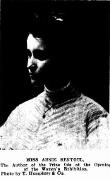Annie Rattray Rentoul, the daughter of notable Presbyterian clergyman and poet Rev. Professor John Laurence Rentoul, took a first class honours degree at the University of Melbourne (B.A. 1905) and taught Greek, Latin and Ancient History at Presbyterian Ladies College for many years from 1913. A children's writer, she was less well known than her sister, the illustrator Ida Rentoul Outhwaite, but was a more productive and acclaimed writer. Their collaboration on The Little Green Road to Fairyland (1922) is perceived as an excellent example of the partnership at its best. Annie was a romantic and her depiction of nature had a supernatural quality, stripped of its harshness, when conveyed to children in her stories of the Australian bush. Examples of this style include Mollie's Bunyip (1904) and Coo-ee: An Australian Fairy Story. However her romanticism could be relieved by humour, as in the more sophisticated but still playful The Lady of the Blue Beads (1908). She was also a contributor, with her sister, father and mother Annie Isobel Rentoul, to At the Sign of the Sword (1915), and wrote the words to a number of individually published songs.
The sumptuous productions of Elves and Fairies (1916), The Enchanted Forest (1921) and The Fairyland of Ida Rentoul Outhwaite: Verses by Annie R. Rentoul: Stories by Grenbry Outhwaite and Annie R. Rentoul (1926) were some of the first special efforts by publishers of the time to produce memorable, visually aesthetic books for children of early school age.
 6926011171709102386.jpg
6926011171709102386.jpg